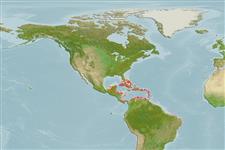Classification / Names
Common names | Synonyms | Catalog of Fishes (gen., sp.) | ITIS | CoL | WoRMS | Cloffa
Actinopterygii (ray-finned fishes) >
Gobiesociformes (Clingfishes) >
Gobiesocidae (Clingfishes and singleslits) > Gobiesocinae
Etymology: Tomicodon: Greek, tomikos, -e, -on = that is useful for cutting (Ref. 45335); reitzae: Named for Elizabeth J. Reitz, Director of the Georgia Museum of Natural History (Ref. 45765).
Environment / Climate / Range
Ecology
Marine; demersal; depth range 0 - 4 m (Ref. 58018). Tropical, preferred ?
Western Central Atlantic: Bahamas, throughout the Greater and Lesser Antilles to the coasts of Venezuela and Colombia, and Isla de Providencia off the coast of Colombia.
Size / Weight / Age
Maturity: Lm ? range ? - ? cm
Max length : 3.5 cm SL male/unsexed; (Ref. 50106)
Short description
Morphology | Morphometrics
Dorsal
spines
(total): 0;
Dorsal
soft rays
(total): 7-9;
Anal
spines: 0;
Anal
soft rays: 7 - 10;
Vertebrae: 34 - 38. Four pairs of trifid incisors in each jaw; very small canines; anus markedly closer to rear margin of disc than to origin of anal fin; disc measuring 5.0 in SL; margin of anterior nostril without dermal flap; externally visible anal fin rays 5; caudal rays 8 (Ref. 45765).
Collected from the shallow surge zone (Ref. 50106). Feeds on small crustaceans (Ref. 50106).
Life cycle and mating behavior
Maturity | Reproduction | Spawning | Eggs | Fecundity | Larvae
Williams, J.T. and J.C. Tyler, 2003. Revision of the western Atlantic clingfishes of the genus Tomicodon (Gobiesocidae), with descriptions of five new species. Smithson. Contrib. Zool. 621:1-26. (Ref. 50106)
IUCN Red List Status (Ref. 115185)
CITES (Ref. 94142)
Not Evaluated
Threat to humans
Harmless
Human uses
More information
Common namesSynonymsMetabolismPredatorsEcotoxicologyReproductionMaturitySpawningFecundityEggsEgg development
Age/SizeGrowthLength-weightLength-lengthLength-frequenciesMorphometricsMorphologyLarvaeLarval dynamicsRecruitmentAbundance
ReferencesAquacultureAquaculture profileStrainsGeneticsAllele frequenciesHeritabilityDiseasesProcessingMass conversion
Tools
Special reports
Download XML
Internet sources
Estimates of some properties based on models
Phylogenetic diversity index (Ref.
82805): PD
50 = 0.5000 [Uniqueness, from 0.5 = low to 2.0 = high].
Bayesian length-weight: a=0.00550 (0.00238 - 0.01266), b=3.11 (2.91 - 3.31), in cm Total Length, based on LWR estimates for this (Sub)family-body shape (Ref.
93245).
Trophic Level (Ref.
69278): 3.2 ±0.4 se; Based on size and trophs of closest relatives
Resilience (Ref.
69278): High, minimum population doubling time less than 15 months (Preliminary K or Fecundity.).
Vulnerability (Ref.
59153): Low to moderate vulnerability (26 of 100) .
